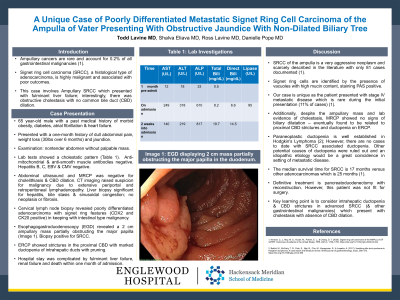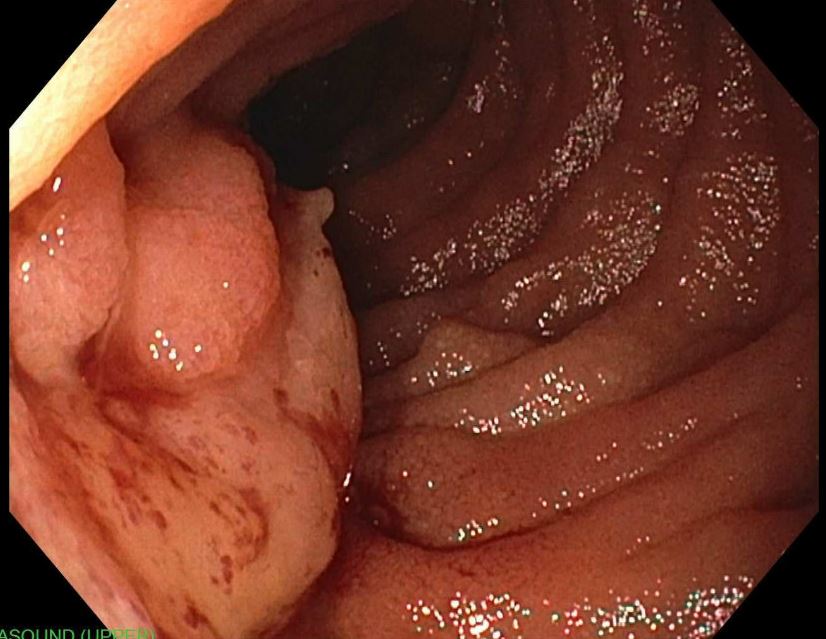Sunday Poster Session
Category: Biliary/Pancreas
P0187 - A Unique Case of Poorly Differentiated Metastatic Signet Ring Cell Carcinoma of the Ampulla of Vater Presenting With Obstructive Jaundice With Non-dilated Biliary Tree
Sunday, October 27, 2024
3:30 PM - 7:00 PM ET
Location: Exhibit Hall E

Has Audio

Todd D. Lavine, MD
Englewood Hospital and Medical Center
Englewood, NJ
Presenting Author(s)
Todd D. Lavine, MD1, Shalva Eliava, MD1, Ross T. Lavine, MD1, Danielle Pope, MD2
1Englewood Hospital and Medical Center, Englewood, NJ; 2Englewood Hospital and Medical Center, Bogota, NJ
Introduction: Ampullary cancers are rare and account for 0.2% of all gastrointestinal malignancies. Most tumors are adenocarcinomas with intestinal or pancreatobiliary origin. Signet ring cell carcinoma (SRCC), a histological type of adenocarcinoma, is highly malignant and associated with poor outcomes. We present a unique case of poorly differentiated metastatic SRCC of the ampulla of Vater presenting with obstructive jaundice in a setting of non-dilated common bile duct (CBD).
Case Description/Methods: 65 year old male with a past medical history of morbid obesity and diabetes, presented with a one month history of dull nonspecific abdominal pain, weight loss and jaundice. Colonoscopy two years ago was normal. Physical exam was significant for icterus and an obese non-tender abdomen without palpable masses. Lab tests showed a cholestatic pattern (Table 1). Abdominal ultrasound and MRCP was negative for cholelithiasis or CBD dilation. CT imaging raised suspicion for malignancy, showing extensive periportal and retroperitoneal lymphadenopathy. This led to cervical lymph node biopsy which revealed poorly differentiated adenocarcinoma with signet ring features positive for CDX2 and CK20 in keeping with intestinal type malignancy. Due to high clinical suspicion of biliary involvement despite a nondilated CBD, esophagogastroduodenoscopy done revealed the culprit - a 2 cm ampullary mass partially obstructing the major papilla. Biopsy results were similar to the cervical lymph node specimen. ERCP showed strictures in the proximal CBD with ductopenia of intrahepatic bile ducts. Hospital stay was complicated by fulminant liver failure, renal failure and death within one month of admission.
Discussion: SRCC of the ampulla is a very aggressive neoplasm and scarcely described in the literature. The most common locations for SRCC are stomach and colon. Our case is unique for different reasons. Firstly, the patient presented with advanced metastatic disease which is rare during the initial presentation. Secondly, despite the ampullary mass and laboratory evidence of cholestasis, MRCP showed no signs of biliary dilatation. The latter is likely related to proximal CBD strictures and ductopenia found during ERCP. Definitive treatment of SRCC, like many ampullary lesions, is pancreatoduodenectomy with reconstruction. Given the suboptimal improvement of deranged LFTs after CBD stent placement and advanced disease, he was deemed not to be a candidate for a surgery or immuno/chemotherapy. This led to an overall poor outcome.

Note: The table for this abstract can be viewed in the ePoster Gallery section of the ACG 2024 ePoster Site or in The American Journal of Gastroenterology's abstract supplement issue, both of which will be available starting October 27, 2024.
Disclosures:
Todd D. Lavine, MD1, Shalva Eliava, MD1, Ross T. Lavine, MD1, Danielle Pope, MD2. P0187 - A Unique Case of Poorly Differentiated Metastatic Signet Ring Cell Carcinoma of the Ampulla of Vater Presenting With Obstructive Jaundice With Non-dilated Biliary Tree, ACG 2024 Annual Scientific Meeting Abstracts. Philadelphia, PA: American College of Gastroenterology.
1Englewood Hospital and Medical Center, Englewood, NJ; 2Englewood Hospital and Medical Center, Bogota, NJ
Introduction: Ampullary cancers are rare and account for 0.2% of all gastrointestinal malignancies. Most tumors are adenocarcinomas with intestinal or pancreatobiliary origin. Signet ring cell carcinoma (SRCC), a histological type of adenocarcinoma, is highly malignant and associated with poor outcomes. We present a unique case of poorly differentiated metastatic SRCC of the ampulla of Vater presenting with obstructive jaundice in a setting of non-dilated common bile duct (CBD).
Case Description/Methods: 65 year old male with a past medical history of morbid obesity and diabetes, presented with a one month history of dull nonspecific abdominal pain, weight loss and jaundice. Colonoscopy two years ago was normal. Physical exam was significant for icterus and an obese non-tender abdomen without palpable masses. Lab tests showed a cholestatic pattern (Table 1). Abdominal ultrasound and MRCP was negative for cholelithiasis or CBD dilation. CT imaging raised suspicion for malignancy, showing extensive periportal and retroperitoneal lymphadenopathy. This led to cervical lymph node biopsy which revealed poorly differentiated adenocarcinoma with signet ring features positive for CDX2 and CK20 in keeping with intestinal type malignancy. Due to high clinical suspicion of biliary involvement despite a nondilated CBD, esophagogastroduodenoscopy done revealed the culprit - a 2 cm ampullary mass partially obstructing the major papilla. Biopsy results were similar to the cervical lymph node specimen. ERCP showed strictures in the proximal CBD with ductopenia of intrahepatic bile ducts. Hospital stay was complicated by fulminant liver failure, renal failure and death within one month of admission.
Discussion: SRCC of the ampulla is a very aggressive neoplasm and scarcely described in the literature. The most common locations for SRCC are stomach and colon. Our case is unique for different reasons. Firstly, the patient presented with advanced metastatic disease which is rare during the initial presentation. Secondly, despite the ampullary mass and laboratory evidence of cholestasis, MRCP showed no signs of biliary dilatation. The latter is likely related to proximal CBD strictures and ductopenia found during ERCP. Definitive treatment of SRCC, like many ampullary lesions, is pancreatoduodenectomy with reconstruction. Given the suboptimal improvement of deranged LFTs after CBD stent placement and advanced disease, he was deemed not to be a candidate for a surgery or immuno/chemotherapy. This led to an overall poor outcome.

Figure: 2 cm mass displayed partially obstructing the major papilla in the duodenum. Biopsy of mass showed poorly differentiated adenocarcinoma with signet ring cell features.
Note: The table for this abstract can be viewed in the ePoster Gallery section of the ACG 2024 ePoster Site or in The American Journal of Gastroenterology's abstract supplement issue, both of which will be available starting October 27, 2024.
Disclosures:
Todd Lavine indicated no relevant financial relationships.
Shalva Eliava indicated no relevant financial relationships.
Ross Lavine indicated no relevant financial relationships.
Danielle Pope indicated no relevant financial relationships.
Todd D. Lavine, MD1, Shalva Eliava, MD1, Ross T. Lavine, MD1, Danielle Pope, MD2. P0187 - A Unique Case of Poorly Differentiated Metastatic Signet Ring Cell Carcinoma of the Ampulla of Vater Presenting With Obstructive Jaundice With Non-dilated Biliary Tree, ACG 2024 Annual Scientific Meeting Abstracts. Philadelphia, PA: American College of Gastroenterology.
